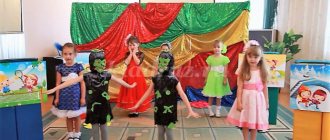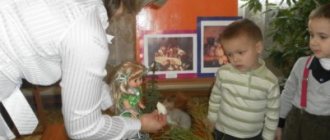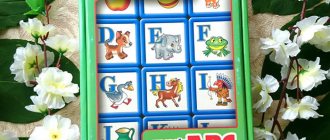Bright pictures with mushrooms, a story about each mushroom and coloring pages with mushrooms.
While exploring the wonderful world of nature, do not forget to tell your children in more detail about mushrooms - unique inhabitants of the natural world, occupying a middle position between the animal and plant kingdoms.
Children about mushrooms - mushroom pictures and stories
Lesson on the topic “Mushrooms” - we think, reason, find out
If you ask kids which group mushrooms belong to, they will no doubt answer – plants.
The following arguments can be given as evidence:
- sedentary lifestyle;
- passive nutrition (substances dissolved in water).
This is where you can give them a surprise by telling them that the structure of a fungal cell is more reminiscent of an animal cell - for example, a beetle or a scorpion, since it is covered with a chitinous (shell) shell. In addition, mushrooms cannot produce their own nutrients when exposed to sunlight, as plants do, which means this also serves as a distinguishing feature.
Ask the kids: where can you most often find a mushroom in the forest? Of course, under the tree. It is not for nothing that many mushrooms get their names from the names of their best friends - the trees under which they grow (aspen, birch). What explains this proximity? Just because mushrooms cannot provide themselves with all the necessary substances, as plants do. Therefore, many of them try to make friends with trees in order to get the products they lack through their roots.
Let's think about what large groups are all mushrooms divided into? Of course, there are edible and non-edible .
Edible and inedible mushrooms
Let the children remember the most famous representatives of each group, and you help them, armed in advance with photo cards depicting mushrooms.
For better assimilation and greater clarity, attach cards with the name of the group on the board or table: “Edible mushrooms” and “Inedible mushrooms.” After discussion, send each picture to the appropriate group. At the same time, it is better to study twin mushrooms in parallel, this will teach kids to be careful in the process of collecting them.
The video presentation “Edible Mushrooms” will help you in studying edible mushrooms:
The healing properties of autumn honey mushrooms
They contain minerals based on zinc and copper, necessary in the process of hematopoiesis.
Traditional medicine uses the ability of honey mushrooms to relax the stomach.
In ancient times, warts were removed using honey mushroom juice.
It was revealed that in honey mushrooms the most effective properties of fighting tumors are endowed with proteins. In 81% of cases, these proteins inhibit the growth of sarcoma, carcinoma, breast cancer, tumors of the nervous system, as well as the development of leukemia. In most cases, after consuming honey mushrooms, the tumors stopped progressing and metastasizing. The active component of winter mushrooms is polysaccharides in the form of white powder.
They dramatically activate the immune system, restoring the level of protection.
Kill pathogenic microflora in areas of inflammation.
Honey mushrooms also have another remarkable property - they stimulate the formation of thrombus-dissolving enzymes. As a result, in some cases it is possible to avoid complex operations.
A tincture or decoction of the legs of honey mushrooms has long been used as a medicine for liver disease and diabetes, and also as an admixture for the preparation of medicines to enhance their effects.
The substances contained in honey mushrooms also fight simple influenza viruses. Taking honey mushroom tincture, which is safe for humans, during a flu epidemic can in many cases protect against this disease. In general, autumn and winter honey mushrooms have a number of useful healing properties:
- activation of the immune system;
- destruction of pathogenic microflora in areas of inflammation;
- normalization of the cardiovascular system;
- restoration of the microflora of the gastrointestinal tract;
- reduction in blood sugar and cholesterol;
- improving the condition of blood vessels;
- activation of the brain and creative potential;
- antitumor and anticancer effects;
- antiviral effect.
Cards with images of mushrooms
As a rule, children know the following types:
Champignon. This mushroom is specially grown in greenhouses, since, unlike many of its fellows, it does not need proximity to trees. What two distinctive features of champignon do you need to remember? The first is the pink or dark brown color of the plates under the cap. The second is the reddish or yellow tint of the mushroom pulp. And, of course, you need to remember the unique aroma of this mushroom, which cannot be confused with anything else if you inhale it at least once.
Picture of champignon for children
Let us immediately remember what is the name of the double of this noble mushroom? Of course, the pale grebe. We look at its image, looking for distinctive features. The most observant will be able to note:
- white color of the plates under the cap;
- the presence of a specific sac at the base of the mushroom stalk.
We add that the flesh of the pale toadstool always remains pale when cut, which is why this mushroom got its name.
Picture of a toadstool for children
Let's move on and remember the following edible mushrooms:
Russula. This mushroom is distinguished by the brightness and variety of colors of its cap. It differs from toadstools in its thick stem, fleshy cap and fragile flesh. And it owes its name to the fact that it does not require long cooking, since it does not contain harmful substances.
Russula picture for children
Boletus. One of the brightest representatives of the union of mushrooms and trees. It is distinguished by the unusual (speckled) color of its stem and the tubular structure of its cap.
Picture of boletus for children
Boletus. From its name it is clear that this mushroom is especially friendly with aspen. And his cap is bright red - the same as aspen leaves in autumn.
Picture of boletus for children
Camelina differs from other mushrooms not only in its color, but also in the fact that its cut acquires a blue tint over time.
Picture of saffron milk cap for children
Honey mushrooms. Friendly mushrooms that grow on the stumps of cut down or dead trees. One of the latest mushrooms, appearing only at the beginning of autumn.
Picture of honey mushrooms for children
Butter. Unusual mushrooms growing in coniferous forests. Their cap is covered with a layer of oily liquid, which is how they got their name.
Picture of boletus for children
Milk mushroom. Everyone's favorite, the king of salted mushrooms. It has an unusual shape and a short leg. It is found in two forms - wet (its surface is covered with fringe and slightly damp) and dry - with a smooth cap.
Picture of breast milk for children
White mushroom, boletus. A noble representative of his species. It has a very thick, fleshy light-colored leg and a cap with a tubular bottom structure.
Picture of white mushroom for children
Chanterelles. Unusual red mushrooms, in which the stem smoothly turns into a cap with a wavy edge.
Picture of chanterelle mushrooms for children
Speaking about chanterelles, you immediately need to remember their dangerous counterpart - false chanterelles, and pay attention to their differences from real ones: unpleasant smell, bright color (with a reddish tint), smooth edges of the cap.
Let us immediately remember the most famous non-edible mushroom - fly agaric . Let's discuss where this name could come from. Children remember the fact that fly agaric is very dangerous for various insects, and our ancestors placed its mushrooms on the windows to prevent flies from flying into the house.
Picture of fly agaric mushroom for children
Every kid knows what this mushroom looks like, its color is so unique. Children will also be interested to know that the fly agaric cap can be not only red, but also brown or yellow.
Another very original inedible mushroom is tinder fungus . This is a perennial parasitic fungus that grows on a living tree or stump. There are quite a lot of different types. He is a forest orderly, decomposing organic compounds into mineral ones. Due to its beneficial properties, it is actively used in medicine. Interestingly, some of its species in some countries can be eaten subject to special preparation.
Picture of tinder for children
And finally, let's remember another unusual representative of the mushroom kingdom - the truffle. This delicious mushroom grows in deciduous forests, and under a layer of soil. Therefore, various methods are used to extract it. Pigs and specially trained dogs are especially good at finding truffles.
Picture of mushroom truffle for children
For greater clarity, we use a poster depicting all common edible and non-edible mushrooms, among which we find familiar ones, and also study previously unseen mushrooms.
Poster with mushrooms
Through a poster on which images of mushrooms are drawn, we smoothly move on to the next, reinforcing part of the lesson - pictures with mushrooms. Some of them display the main features of each mushroom, making it recognizable. On others we see the general outlines of mushrooms. You can offer the kids riddles or poems about mushrooms that match the pictures.
A picture for children of a mushroom (poems about mushrooms, riddles about mushrooms) are used to consolidate knowledge of the names of the main parts of the mushroom; with the help of them we try to remember how and in what parts, as well as in their characteristic habitat, the mushrooms that we studied today differ from each other.
Popular message topics
- Road traffic accident
The topic of road traffic accident is very relevant today, because quite often we see the consequences of various types of accidents on the roads. This happens due to insufficient knowledge of traffic rules, - Yak way of life, habitat
The yak is a wild forest bull, similar in appearance to a bison or bison, the strongest representative of artiodactyls on the planet. The animal's body weight can reach up to one and a half tons, and its length can be up to 4.5 meters. Because of the hump on the back it seems - Cows
are herbivores. In the cold season, a cow can be fed thanks to grain crops, as well as corn. But in the summer, an adult animal can eat at least 45 kg of grass. If the cow is a dairy breed,
Riddles about mushrooms
For example, you can offer the following poems and riddles:
My hat -
Where the needles are.
Glistens in the sun
It slips in your hands. (oiler)
With a thick leg, small,
He hid in the moss... (boletus).
If I get into the basket -
You will have a supply for the winter.
I taste very good!
Did you guess it? This is... (milk).
They lead a friendly round dance
Red sisters.
Everyone will immediately understand:
In front of him... (chanterelles).
Sits bravely on a stump
A bunch of brave guys.
Everyone can easily recognize them:
Who doesn’t know about….(again)?
All shades and colors
Those mushrooms have caps.
Collect them without haste,
Very fragile...(russula).
Look at the video riddles about mushrooms:
As a conclusion to the lesson, to include motor memory in the work, in the final part we invite the kids to work with coloring. The mushroom coloring page puts kids in a calm mood.
Appearance and description
It is quite easy to recognize the honey mushroom due to some unique appearance features. The mushroom has a thin but long stalk that can grow up to 16 cm in height. Its color is often light brown, but depending on the species and environmental conditions it can have a dark tint. Moreover, at the base its shade is darker. The leg sometimes has a ring resembling a skirt. It helps to hold the top.
Most honey mushrooms have a thin stem and a rounded cap.
The cap of young mushrooms has a spherical shape, with barely noticeable scales on the surface.
Initially, its dimensions are no more than 2 cm, but gradually this parameter increases to 11 cm. As it grows, the scales disappear and the top becomes smooth. Also, its outlines are smoothed out and begin to resemble an umbrella. The color of the cap almost completely matches the stem. It can be light beige or with a red tint. Interesting fact : the cap of some honey mushrooms can become covered with mucus, which is why the surface begins to shine like a butter mushroom.
The reverse side of the cap consists of parallel folds running from the edge to the stem. The flesh of honey mushrooms is soft and smooth. It absorbs moisture well, so after cooking the mushrooms remain juicy and pleasant to the taste.
Mushroom coloring pages
Mushroom picture
Mushroom coloring book
Fly agaric picture for children
Fly agaric coloring book for children
Autumn mushroom picture
Autumn mushroom coloring
After finishing the work, you need to consider all the results and even make an impromptu exhibition of mushrooms painted in bright colors.
Growing at home
Honey mushrooms can be grown in an artificial environment; you just need to recreate conditions favorable for this. You need to choose a place where there is shade most of the time of the day. The stump of a deciduous plant sits there; birch, pear or apple trees are best suited. After preliminary wetting the surface of the trunk, pieces of honey mushrooms are planted in its cracks and covered with moss. Next year, when the season comes, the stump will be covered with fast-growing mushrooms.
Interesting fact : a correctly planted piece of honey mushroom can produce a harvest for six years.
Growing honey mushrooms in a jar
If a person does not have his own garden, he can grow honey mushrooms in jars. To do this, you need to fill them by a third with bran, and fill the rest with sawdust from trees. Sprinkle flour and starch on top. The resulting mixture is poured with water and boiled thoroughly. The boiling process continues until most of the liquid has turned to steam, then the jars are cooled. When the temperature of the contents approaches room temperature, pieces of mushrooms are planted at the top, and then the necks are covered with lids with holes made to allow air circulation. In about a month, the tops of young honey mushrooms will appear on the surface. After this, the lid must be removed so as not to interfere with the growth of mushrooms.




